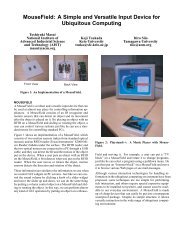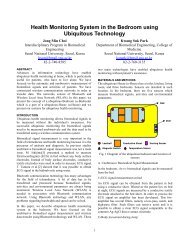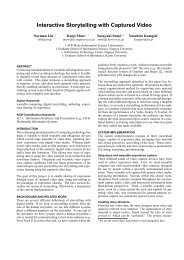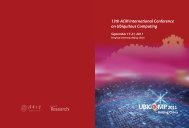Workshops - UbiComp
Workshops - UbiComp
Workshops - UbiComp
- No tags were found...
Create successful ePaper yourself
Turn your PDF publications into a flip-book with our unique Google optimized e-Paper software.
notion of partial/total immersion with that of a wearable interface,as opposed with total immersive systems where theuser is completely immersed in the virtual world. An secondpotential advantage of such system could be that if there isan uncanny valley for artificial environments, as suggestedin the introduction, then it may constitute an advantage thatthese systems secure a cognitive distance between the renderedenvironment and the user’s ’reality’.ACKNOWLEDGEMENTWe would like to thank all the people that contributed to theconstruction of the ’Time Machine’: Jrmy Hautreux, PierreLe Gargasson, Benot Malabry and Antoine Lelarge, ClmentMona, Julien Pg, as well as their professors M. Crison andM. LeRenard and M. Geslin. Thanks to Carson Reynolds forinteresting suggestions and feedback.REFERENCES1. Ho, Chin-Chang and Macdorman and Karl F. andPramono, Dwi Z. A. D. Human emotion and theuncanny valley: a GLM, MDS, and Isomap analysis ofrobot video ratings In HRI ’08: Proceedings of the 3rdACM/IEEE international conference on Human robotinteraction, Amsterdam, The Netherlands, (2008),169–1762. P. Milgram and F. Kishino. A Taxonomy of MixedReality Visual Displays. In IEICE Transactions onInformation Systems, volume E77-D (1994).3. M. L. Heilig. Sensorama simulator. Patent 3050870(1962).4. D. A. Bowman and R. P. Mcmahan. Virtual Reality:How Much Immersion Is Enough?. In Computer,volume 40 (2007), 36–43.5. K. Cater and A. Chalmers and P. Ledda. Selectivequality rendering by exploiting human inattentionalblindness: looking but not seeing. In VRST ’02:Proceedings of the ACM symposium on Virtual realitysoftware and technology, ACM (2002), 17–24.6. M. Botvinick and J. Cohen. Rubber hands ’feel’ touchthat eyes see.. In Nature, volume 391 (1998).7. L. R. Hochberg and M. D. Serruya and G. M. Friehsand J. A. Mukand and M. Saleh and A. H. Caplan andA. Branner and D. Chen and R. D. Penn and J. P.Donoghue. Neuronal ensemble control of prostheticdevices by a human with tetraplegia. In Nature volume442, Nature Publishing Group, 164–171.8. W. H. Dobelle. Artificial vision for the blind byconnecting a television camera to the visual cortex. InASAIO journal, American Society for Artificial InternalOrgans (2000), 3–9.9. T. Maeda and H. Ando and M. Sugimoto. VirtualAcceleration with Galvanic Vestibular Stimulation inVirtual Reality Environment. In VR ’05: Proceedings ofthe 2005 IEEE Conference 2005 on Virtual Reality,IEEE Computer Society (2005), 289–290.10. C. Cruz-Neira and D. J. Sandin and T. A. DeFanti andR. V. Kenyon and J. C. Hart. The CAVE: audio visualexperience automatic virtual environment. In Commun.ACM, ACM (1992), 64–72.11. C. Mona and A. Zerroug and J. Hautreux and P. LeGargasson and B. Malabry and J. Pégé and A. Lelarge.Time Machine: VERDUN 1916.http://www.time-machine.info/, ESIEA / ESCIN(2007).12. S. Kuntz. A VR Geek Blog / Laval Virtual 2007.http://cb.nowan.net/blog/2007/04/23/laval-virtual-2007/13. A. S. Carlin and H. G. Hoffman and S. Weghorst.Virtual reality and tactile augmentation in the treatmentof spider phobia: a case report.. In Behaviour researchand therapy, volume 35 (1997), 153–158.14. K. Sato and Y. Sato and M. Sato and S. Fukushima andY. Okano and K. Matsuo and S. Ooshima and Y.Kojima and R. Matsue and S. Nakata and Y. Hashimotoand H. Kajimoto. Ants in the Pants HOW?.http://www.mushi-how.com/, The University ofElectro-Communications (2008).15. S. Bouchard and S. Côté and J. St-Jacques and G.Robillard and P. Renaud. Effectiveness of virtual realityexposure in the treatment of arachnophobia using 3Dgames. In Technol. Health Care, IOS Press (2006),19–27.37






